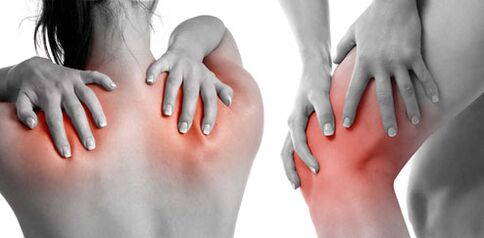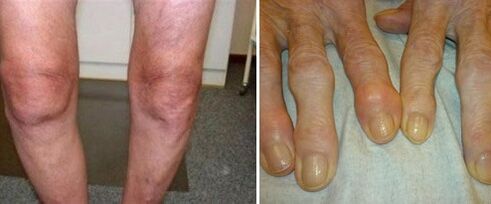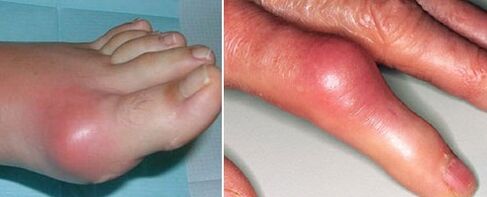
Joint pain can make life unbearable.After the doctor's visit, the record of the diagnosed arthrosis or arthritis appears on the outpatient card.
People who are far from medicine have no idea of the difference between arthritis and arthrosis and mistakenly consider them to be the same disease.
In fact, these are two completely different pathological processes that can occur simultaneously.
Arthrosis
Arthrosis refers to degenerative-inflammatory processes and develops due to age-related changes in the structure of cartilage tissue.
It affects the moving joints of large bones, less often the joints of the fingers.
Appearance of the joint in arthrosis

The main cause of pathological changes is metabolic disorders of the cartilage.Violation of cartilage trophism leads to irreversible loss of proteoglycans and loss of tissue elasticity.
Dystrophic changes in the cartilage cause pathological changes in the structure of the joint surface of the bones.Over time, the degeneration process spreads to the periarticular tissues.
Types of arthrosis
Primary and secondary arthrosis are distinguished based on their origin.
The primary form affects previously healthy joints and is the result of age-related changes and inadequate physical activity.The time of appearance of the first symptoms of arthrosis depends on hereditary predisposition, characteristics of professional activity and lifestyle.
Traditionally, people over the age of 45 are considered at risk, but today there is a continuous trend towards earlier occurrence.The disease primarily affects women, but with age the dependence on gender gradually eases.
Secondary arthrosis develops on the background of a previous injury or certain diseases of a different nature, including:
- autoimmune processes;
- metabolic disorders;
- endocrine dysfunction;
- pathologies of the structure of bone joints;
- genetic diseases;
- inflammatory processes.
Secondary arthrosis is not associated with the aging process and can occur at any age.
There are three stages in the development of the disease.
In the first stage, changes occur in the synovial fluid.The nutrition of the cartilage is interrupted, and its resistance to stress decreases.Roughness appears on the surface of the cartilage, inflammation develops, accompanied by pain.
As the disease progresses to the second stage, the pain becomes habitual, and the course of the accompanying inflammation becomes wave-like.The cartilage begins to deteriorate and compensatory bone growths form at the edges of the joint area.Periarticular muscles are involved in pathological processes.
The third stage is characterized by severe depletion of articular cartilage, with areas of complete tissue destruction.Degenerative processes lead to irreversible anatomical changes, including changes in the axis of the limb.The functioning of the ligament apparatus is interrupted, pathological mobility appears in the affected joint against the background of limited natural mobility.
They are distinguished according to the location of the injury:
- gonarthrosis,
- coxarthrosis,
- spondyloarthrosis,
- arthrosis of the interphalangeal joints of the hands.
Other localizations of the pathology are relatively rare.
Gonarthrosis, knee joint arthrosis
Risk factors for the development of the disease include hereditary predisposition, knee injuries due to overuse or occupational characteristics.
According to statistics, arthrosis of the knee joints is diagnosed more often in women.
In the early stages of development, the disease manifests itself in discomfort and aching pain in the affected joint.Depending on the causes of the change, several forms of gonarthrosis are distinguished.
Some are characterized by a long-term lack of progression;the patient's condition remains stable for decades.However, there are also those that progress quickly and lead to loss of mobility in the affected limb.
Coxathrosis, hip joint arthrosis

With this disease, the classic clinical picture of arthrosis can be observed.
The first symptom of coxarthrosis is discomfort in the hip joint after physical activity.
In case of progressive coxarthrosis, the pain increases, stiffness and limited movement appear.
Patients with severe coxarthrosis spare the affected limb, avoid stepping on it, and choose a body position in which the pain is least noticeable when standing.
Spinal arthrosis, spondyloarthrosis

Spondyloarthrosis refers to pathologies that develop against the background of degenerative processes of the intervertebral discs.
The first and main symptom of the development of arthrosis of the spine is pain when bending from side to side or back and forth.
When a person gets into a horizontal position, the pain gradually decreases.
Over time, in the absence of proper treatment, the mobility of the affected part of the spine can be completely lost.
Without proper treatment, spinal arthrosis can cause intervertebral hernias and joint deformation.In severe cases, the patient loses the ability to perform normal movements and becomes disabled.
Arthrosis of the interphalangeal joints of the hands
The disease mainly affects women.Early symptoms of arthrosis include pain when touching cold water and stretching the fingers.Over time, the joints are deformed due to the compaction of adjacent tissues and the formation of characteristic bony outgrowths.
The course of the disease is wave-like, in the acute stage, the joints swell, partially lose mobility, and sensitivity to touch may also be impaired.
Treatment of arthrosis
It is impossible to completely cure arthrosis with the help of modern medicine.However, timely diagnosis and complex therapy aimed at preventing further destruction of the cartilage helps to stabilize the condition of the affected joint and significantly improves the patient's quality of life.
First of all, the load on the locomotor system must be reduced.Doctors recommend avoiding carrying heavy objects, staying in one position for long periods of time, and limiting time spent on your feet.Weight loss is vital for overweight patients.
In the medical treatment of arthrosis, the following are used:
- nonsteroidal anti-inflammatory drugs, internally in the form of injections or tablets, and externally as part of ointments.The form and order of application are prescribed depending on the patient's condition;
- drugs from the group of chondroprotectors to maintain the condition of cartilage tissue;
- steroidal anti-inflammatory drugs in the form of intra-articular injections.It is prescribed in severe cases;
- hyaluronic acid preparations to improve joint mobility.
In addition, warming compresses and ointments, drugs that activate blood microcirculation and metabolic processes, antioxidants and selenium microelement-vitamin complexes, as well as physiotherapy treatment are prescribed.In severe cases, surgical intervention is necessary.
During the period of remission, the patient is recommended an exercise therapy, which is selected according to the characteristics of the course of the disease.
Arthritis
Arthritis is an inflammatory disease that occurs as an underlying disease, concurrent pathology, or as a complication of a previous infectious disease.
The appearance of joints with arthritis

Typical causes of arthritis include:
- metabolic disorders in the body;
- lack of vitamins;
- injuries;
- autoimmune diseases;
- infectious lesions of various etiologies.
Unlike arthrosis, the pathological processes of arthritis affect the periarticular tissues.The appearance of pain does not depend on physical activity and body position, and it often bothers you at night.
The noise characteristic of the early stage of arthrosis is rarely observed in the joints.A general blood test indicates the presence of an inflammatory process;characteristic degenerative changes of the cartilage are rarely observed when examining joints.
Pain is a common symptom of both diseases.Any unusual and unpleasant feeling in the joints is a good reason to see a doctor.The success of the treatment depends to a large extent on the timely recognition and treatment of the disease.
Types of arthritis
Based on their occurrence, arthritis is divided into several types:
- infectious arthritis.They develop as an independent disease due to infection of wounds (primary infectious arthritis) or when a pathogen enters the bloodstream from the organs affected by the infection (secondary arthritis);
- rheumatoid arthritis.This chronic disease is of infectious-autoimmune origin and usually develops in middle-aged and older people;
- gouty arthritis.The inflammatory process is triggered by micro-traumatization of the cartilage surface by crystals of uric acid salts formed in the joint capsule;
- traumatic arthritisit develops as a reaction to trauma, but it can also develop several years after its consequences have been eliminated;
- juvenile rheumatoid arthritisAffects children under 16 years of age.The causes of this disease are not yet known.The course is chronic and progressive.
The course of arthritis can be acute or chronic.In the acute course, the disease develops rapidly, with severe swelling, severe pain in the affected area, local or general temperature rise.
In the case of chronic arthritis, the symptoms increase gradually and the disease can progress over years.If not treated at the right time or not properly, acute arthritis can become chronic.
Monoarthritis and polyarthritis are distinguished according to the characteristics of the lesion.In monoarthritis, the lesion is localized on one joint;if several joints are involved in the pathological process, the diagnosis of polyarthritis is made.
Treatment of arthritis
The treatment strategy for arthritis depends on the causes of the disease and the severity of the patient's condition.In case of infectious arthritis, patients are prescribed a course of antibiotics or other drugs depending on the nature of the pathogen.
To eliminate inflammation, nonsteroidal anti-inflammatory drugs are used in the form of injections, tablets, and/or externally as an ointment or gel.
In addition, drugs belonging to the group of chondroprotectors, antihistamines and general restorative agents may be prescribed.In some cases, patients are prescribed drugs that improve blood microcirculation.
In addition to drug treatment, patients are prescribed physiotherapy procedures and, during the period of remission, gymnastic exercises.
In severe and advanced cases, surgery may be necessary.
Without specialist help, arthritis and arthrosis can lead to disability.
Self-medication of joint diseases is contraindicated;in the vast majority of cases, the patient's condition gradually worsens.
Any change in the functioning of the joint is a reason to visit the doctor.
Preventive measures
In order to prevent arthritis and arthrosis, it is important to optimize physical activity, avoiding overload.People diagnosed with the disease, as well as those at risk, should change their diet in favor of healthy foods, reduce alcohol consumption and stop smoking.
People prone to obesity are advised to maintain a normal body weight, as the increased load on the musculoskeletal system can trigger or accelerate pathological changes.
In order to recognize the disease in an early stage, it is important to carry out regular preventive examinations.


























